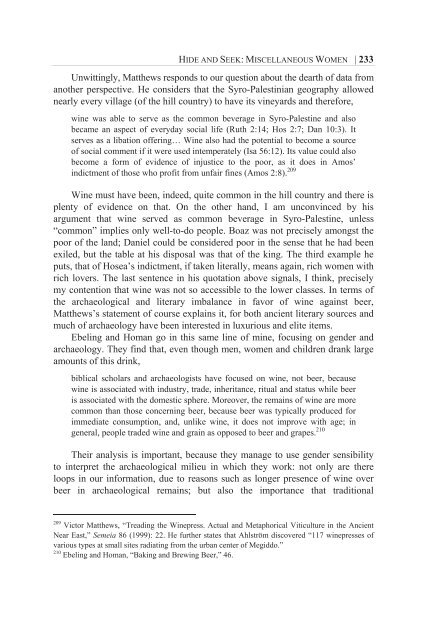Women at Work in the Deuteronomistic History - International Voices ...
Women at Work in the Deuteronomistic History - International Voices ...
Women at Work in the Deuteronomistic History - International Voices ...
Create successful ePaper yourself
Turn your PDF publications into a flip-book with our unique Google optimized e-Paper software.
HIDE AND SEEK: MISCELLANEOUS WOMEN | 233<br />
Unwitt<strong>in</strong>gly, M<strong>at</strong><strong>the</strong>ws responds to our question about <strong>the</strong> dearth of d<strong>at</strong>a from<br />
ano<strong>the</strong>r perspective. He considers th<strong>at</strong> <strong>the</strong> Syro-Palest<strong>in</strong>ian geography allowed<br />
nearly every village (of <strong>the</strong> hill country) to have its v<strong>in</strong>eyards and <strong>the</strong>refore,<br />
w<strong>in</strong>e was able to serve as <strong>the</strong> common beverage <strong>in</strong> Syro-Palest<strong>in</strong>e and also<br />
became an aspect of everyday social life (Ruth 2:14; Hos 2:7; Dan 10:3). It<br />
serves as a lib<strong>at</strong>ion offer<strong>in</strong>g… W<strong>in</strong>e also had <strong>the</strong> potential to become a source<br />
of social comment if it were used <strong>in</strong>temper<strong>at</strong>ely (Isa 56:12). Its value could also<br />
become a form of evidence of <strong>in</strong>justice to <strong>the</strong> poor, as it does <strong>in</strong> Amos’<br />
<strong>in</strong>dictment of those who profit from unfair f<strong>in</strong>es (Amos 2:8). 209<br />
W<strong>in</strong>e must have been, <strong>in</strong>deed, quite common <strong>in</strong> <strong>the</strong> hill country and <strong>the</strong>re is<br />
plenty of evidence on th<strong>at</strong>. On <strong>the</strong> o<strong>the</strong>r hand, I am unconv<strong>in</strong>ced by his<br />
argument th<strong>at</strong> w<strong>in</strong>e served as common beverage <strong>in</strong> Syro-Palest<strong>in</strong>e, unless<br />
“common” implies only well-to-do people. Boaz was not precisely amongst <strong>the</strong><br />
poor of <strong>the</strong> land; Daniel could be considered poor <strong>in</strong> <strong>the</strong> sense th<strong>at</strong> he had been<br />
exiled, but <strong>the</strong> table <strong>at</strong> his disposal was th<strong>at</strong> of <strong>the</strong> k<strong>in</strong>g. The third example he<br />
puts, th<strong>at</strong> of Hosea’s <strong>in</strong>dictment, if taken literally, means aga<strong>in</strong>, rich women with<br />
rich lovers. The last sentence <strong>in</strong> his quot<strong>at</strong>ion above signals, I th<strong>in</strong>k, precisely<br />
my contention th<strong>at</strong> w<strong>in</strong>e was not so accessible to <strong>the</strong> lower classes. In terms of<br />
<strong>the</strong> archaeological and literary imbalance <strong>in</strong> favor of w<strong>in</strong>e aga<strong>in</strong>st beer,<br />
M<strong>at</strong><strong>the</strong>ws’s st<strong>at</strong>ement of course expla<strong>in</strong>s it, for both ancient literary sources and<br />
much of archaeology have been <strong>in</strong>terested <strong>in</strong> luxurious and elite items.<br />
Ebel<strong>in</strong>g and Homan go <strong>in</strong> this same l<strong>in</strong>e of m<strong>in</strong>e, focus<strong>in</strong>g on gender and<br />
archaeology. They f<strong>in</strong>d th<strong>at</strong>, even though men, women and children drank large<br />
amounts of this dr<strong>in</strong>k,<br />
biblical scholars and archaeologists have focused on w<strong>in</strong>e, not beer, because<br />
w<strong>in</strong>e is associ<strong>at</strong>ed with <strong>in</strong>dustry, trade, <strong>in</strong>heritance, ritual and st<strong>at</strong>us while beer<br />
is associ<strong>at</strong>ed with <strong>the</strong> domestic sphere. Moreover, <strong>the</strong> rema<strong>in</strong>s of w<strong>in</strong>e are more<br />
common than those concern<strong>in</strong>g beer, because beer was typically produced for<br />
immedi<strong>at</strong>e consumption, and, unlike w<strong>in</strong>e, it does not improve with age; <strong>in</strong><br />
general, people traded w<strong>in</strong>e and gra<strong>in</strong> as opposed to beer and grapes. 210<br />
Their analysis is important, because <strong>the</strong>y manage to use gender sensibility<br />
to <strong>in</strong>terpret <strong>the</strong> archaeological milieu <strong>in</strong> which <strong>the</strong>y work: not only are <strong>the</strong>re<br />
loops <strong>in</strong> our <strong>in</strong>form<strong>at</strong>ion, due to reasons such as longer presence of w<strong>in</strong>e over<br />
beer <strong>in</strong> archaeological rema<strong>in</strong>s; but also <strong>the</strong> importance th<strong>at</strong> traditional<br />
209 Victor M<strong>at</strong><strong>the</strong>ws, “Tread<strong>in</strong>g <strong>the</strong> W<strong>in</strong>epress. Actual and Metaphorical Viticulture <strong>in</strong> <strong>the</strong> Ancient<br />
Near East,” Semeia 86 (1999): 22. He fur<strong>the</strong>r st<strong>at</strong>es th<strong>at</strong> Ahlström discovered “117 w<strong>in</strong>epresses of<br />
various types <strong>at</strong> small sites radi<strong>at</strong><strong>in</strong>g from <strong>the</strong> urban center of Megiddo.”<br />
210 Ebel<strong>in</strong>g and Homan, “Bak<strong>in</strong>g and Brew<strong>in</strong>g Beer,” 46.




